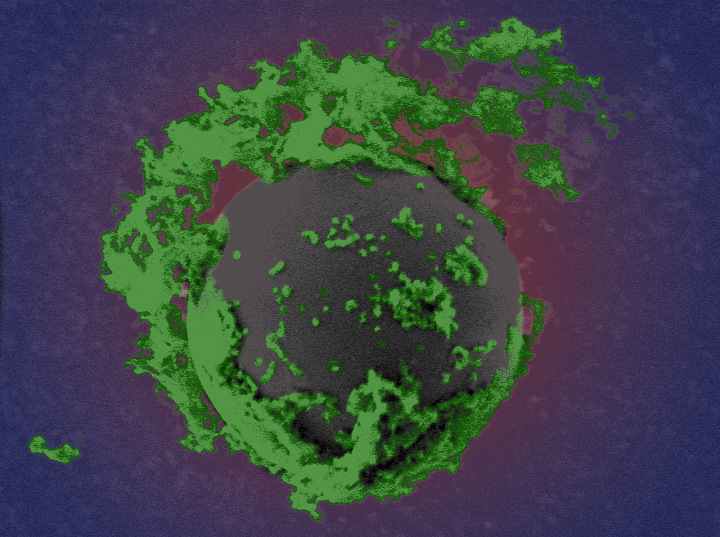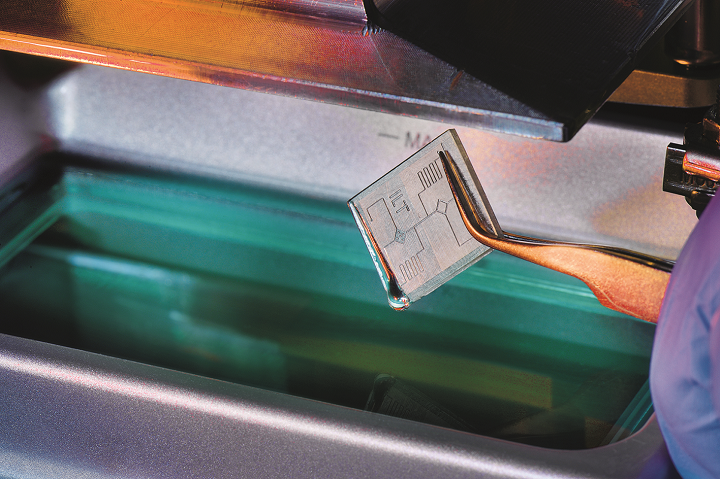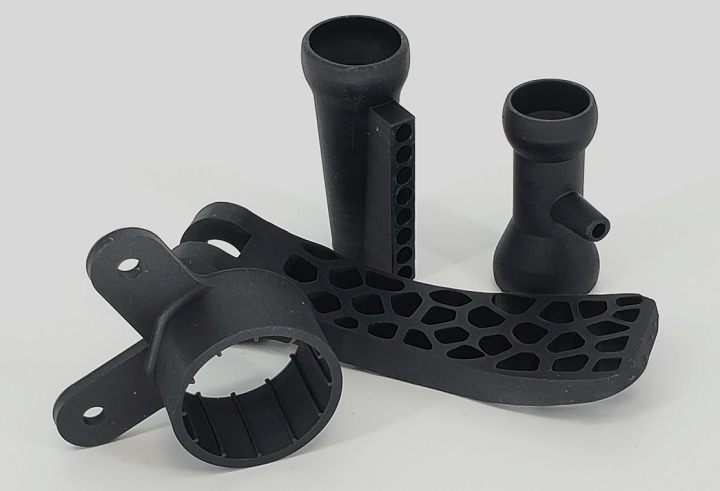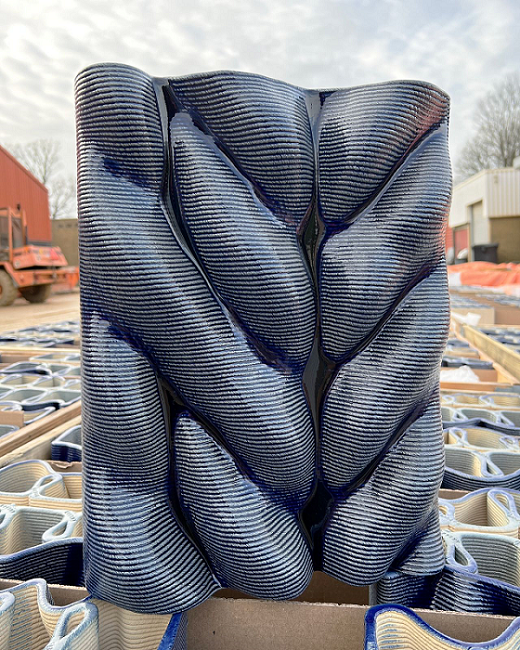The focus of today’s 3D Printing News Briefs is materials, materials, and more materials! Starting with research, ORNL scientists found that naturally derived materials are fit for 3D printing. Fraunhofer ILT and a few industrial partners developed a novel system for producing high-resolution microcomponents by photo-crosslinking. Mechnano announced the release of a tough electrostatic dissipative photopolymer resin. Finally, the New Delft Blue project, designed by Studio RAP, uses 3D printing to reinterpret the decorative qualities and design of Delft Blue porcelain.
ORNL Finds Naturally-Derived Compound Materials Fit for AM
 Researchers found that moderate levels of ash — sometimes found as spheres in biomass — do not significantly affect the mechanical properties of biocomposites made up of corn stover, switchgrass and PLA thermoplastic. Credit: Andy Sproles/ORNL, U.S. Dept. of Energy
Researchers found that moderate levels of ash — sometimes found as spheres in biomass — do not significantly affect the mechanical properties of biocomposites made up of corn stover, switchgrass and PLA thermoplastic. Credit: Andy Sproles/ORNL, U.S. Dept. of EnergyA team led by Oak Ridge National Laboratory (ORNL) researchers have found that the presence of ash minerals in plants doesn’t make much difference in the 3D printability of new naturally-derived compound materials designed specifically for additive manufacturing. It was thought that high-ash biomass residue from biorefining could be used to help lower the cost of producing materials and sustainable fuels, so the research team looked into it. They learned that when mixed with polylactic acid, fibers sourced from switchgrass and corn stover (leaves, stalks, and cobs of corn plants left in a field after harvest) created biocomposites with properties that were “satisfactory” for 3D printing. The presence of ash spheres actually seemed to improve the flow of material for extrusion printing, and the researchers will now explore more biomass materials, and test the composites in a large-volume printer at ORNL.
ORNL’s Xianhui Zhao said, “We went as high as 12% ash content on our corn stover biocomposite and found mechanical properties like stress and strain tolerance and tensile strength to be acceptable.”
Fraunhofer ILT & Partners 3D Printing Microcomponents with Novel System
 Sample component produced in a resin bath from the HoPro3D system.
Sample component produced in a resin bath from the HoPro3D system.The Fraunhofer Institute for Laser Technology ILT, together with partners LightFab GmbH, Bartels Mikrotechnik GmbH, and Miltenyi Biotec GmbH, developed a novel 3D printer that uses photo-crosslinking to produce high-resolution microcomponents. The project was called “High productivity and detail accuracy in additive manufacturing by combining UV polymerization and multiphoton polymerization – HoPro-3D,” and the results mean that customized polymer microstructures can be produced economically on one machine. The HoPro-3D printer combines the high-resolution laser process of multiphoton polymerization (MPP) with scrolling digital light processing (DLP), and features two selectable exposure systems: MPP is for high precision, with scrolling DLP is for high build rates. The DLP module emits at a 365 nm wavelength to expose the basic structures of a microcomponent with a 10 μm pixel resolution, and complementing it is a femtosecond laser and the MPP module, which can write contour lines with a 2 μm resolution.
The system’s control software makes it possible to smoothly switch between the two modules, and CAD data can be used to determine when it makes sense to switch. The layer-by-layer approach from the modules enables printing of fine MPP structures on top of printed DLP structures, which quickly creates extended components that have a complex structure and high-resolution details, with a footprint of up to 60 x 100 mm². The laboratory prototype of the HoPro-3D system could be tested and optimized as part of the Fraunhofer SiCellNet network, and in the follow-up project, “Precise assembly by high resolution seamless 3D printing – PANDA,” Fraunhofer ILT and its partners have been expanding the performance DLP-based processes. Any knowledge gleaned from PANDA will be applied to the original HoPro-3D to improve economic efficiency of 3D printing. Potential applications for a system like this include microfluidic chips for laboratory diagnostics, micromechanical components, and more.
Mechnano Announces Release of New Tough ESD Resin, Based on MechT
Mechnano has developed another AM resin, Tough ESD, based on its MechT technology that uses discrete Carbon Nanotubes (dCNTs). The new photopolymer, which will be released as a white-label resin to interested partners, builds on the company’s Formula1 resin—the industry’s first static dissipative photopolymer to use dCNTs. Tough ESD delivers isotropic electrostatic dissipative (ESD) properties to parts printed using vat photopolymerization processes, and also offers increased impact resistance and elongation at break. Mechnano’s original Formula1 is good for electronics manufacturing processes that need rigidity, while Tough ESD is meant for parts with fine features that will be subjected to more abuse with potential breakage, such as enclosures, assembly aids, and ESD tooling.
“Our latest innovation builds on our original effort, unleashing dCNT potential in AM materials to achieve extraordinary performance. MechT-enhanced resins expand, improve, and add material properties for a wide array of applications,” said Bryce Keeler, President of Mechnano.
“Additive manufacturing hardware and software continue to advance, so we are excited to offer additional material solutions that are compatible and to expand the scope of AM applications.”
Studio RAP 3D Printing 2,850 Clay Tiles for New Delft Blue Project
Dutch architectural design company Studio RAP, based in Rotterdam, is on a mission to design and realize groundbreaking architecture that pushes boundaries and inspires people around the world. In order to “challenge the traditional way of building and rethink the architectural profession,” the company uses robotic arm 3D printers for its projects, including New Delft Blue, which is “scaling up 3D printing in architecture” in the historic Dutch city of Delft. Studio RAP designed the project, and has 3D printed nearly 2,850 custom façade tiles for it. Molds were not used because each clay tile is completely unique.
“This project reinterprets the world-famous decorative qualities and design vocabulary of Delft Blue porcelain. By fusing 3D clay printing, computational design, and artisanal glazing, New Delft Blue hopes to unfold a new architectural potential of ceramic ornamentation of the 21st century.”
Koninklijke Tichelaar B.V. is firing and glazing the 3D printed tiles for New Delft Blue, and other partners include real estate developers BPD Gebiedsontwikkeling and Ballast Nedam Development; architects VYA and Sjoerd Beerends; and main contractor Ballast Nedam.
Subscribe to Our Email Newsletter
Stay up-to-date on all the latest news from the 3D printing industry and receive information and offers from third party vendors.
Print Services
Upload your 3D Models and get them printed quickly and efficiently.
You May Also Like
Nikon SLM Solutions Sells SLM 500 to Primary Weapon Systems to Expand Suppressor Production
Primary Weapons Systems (PWS) is a Boise, Idaho-based manufacturer of suppressors, firearms, and related components. A subsidiary of Vigilant Gear and a sister company to aftermarket Glock slide manufacturer Lone...
3DPOD 261: Tooling and Cooling for AM with Jason Murphy, NXC MFG
Jason Murphy´s NXC MFG (Next Chapter Manufacturing) is not a generalist service; instead, the company specializes in making tooling. Using LPBF and binder jet, the company produces some of the...
HP and Firestorm Labs Form Partnership to Use Multi Jet Fusion 3D Printers in Deployable Factories
HP Inc., maker of a range of additive manufacturing (AM) solutions including the Multi Jet Fusion (MJF) ecosystem, has announced a partnership with Firestorm Labs, a developer of containerized, deployable...
3D Printing News Briefs, July 2, 2025: Copper Alloys, Defense Manufacturing, & More
We’re starting off with metals in today’s 3D Printing News Briefs, as Farsoon has unveiled a large-scale AM solution for copper alloys, and Meltio used its wire-laser metal solution to...


































